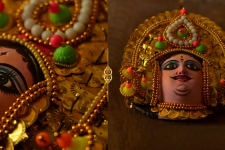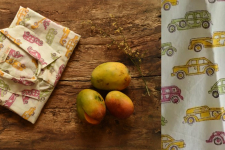- Availability: 2
- Made & Mkt by: Antarang
- Product Code: 4101-SD20-040-02
- Weight: 850.00g
- Dimensions: 19.00cm x 8.00cm x 8.00cm
Available Options
The typical dispatch time is 2-3 days; however, in special cases, it may take longer. Please refer to the product details section for specific timelines. Once dispatched, we will share the tracking details with you.
For returns, you can file a request within 24 hours of receiving the product. If the package is damaged, please make a video while unboxing and share images of the damaged item along with your return request.

When nomads settled down in cities at the beginning of civilization, it was a turning point for the way humans would live. A settled life meant agriculture, which meant excess grain, and that gave rise to trading and exchange and eventually seals and currency. Staying in one place in cities, it also implied construction and storage.

This is where the use of mud came into existence, with the production of bricks and storage vessels. These evidences have been found in excavations at Harappa and Mohenjo Daro and many other ancient cities of Indus Valley Civilization, which existed about 5000 years ago. Thousands of years after the Indus Valley Civilization’s decline in around 1700B.C, the land has seen innumerable kingdoms, wars, industries and cultures, but history remains at a standstill at the excavations of those ancient cities, the origins of our modern lives.

The gold and beaded jewelry, terracotta toys and bronze figurines, seals with symbols found at the sites reflect the objects we use till this day. One such object, unchanged through millennia is the earthen pot, a ubiquitous entity seen all over the country.
In the small village of Gujarat, Khavda-Bhuj, for generations, craftsmen have been making earthen pots with the same process and designs as those seen in indus vally excavations. Khavda is a small village, with skilled craftsmen like Abdul bhai whose forefathers migrated here from Sindh a few hundred years back. They craft a wide variety of vessels such as matka for water storage, Plate, diya, boxes, ketli, and kulada to keep buttermilk.

An earthen pot is a very simple design, but making it requires a set of skills and material, just as any other craft. The potters are so particular about the raw material, that they get mud from a specific acre (A lake) area near village. To make the mud finer, they grind and sieve it. Then they put the mud in water for 2-3 days and it becomes soft enough to be given any desired shape.

This soft clay is shaped into a pot on a potter’s wheel and left to dry in shade, then Kumbhar women use red, black, and white clay-based paints to decorate each piece of pottery with distinct community-specific designs. After a while, it is cleaned and put in the sun to dry and then baked in a furnace, powered by simple and locally available fuels of dry wood and cow dung.

This human need for adornment and decoration is timeless. The pots of Khavda get their red colour from Geru, a type of soil (ocher/ umber), and the black and white dots and stripes are also made with natural material. The terracotta pots of Khavda are distinct from the ones we may see elsewhere, because of their painting and form which is a result of repeated cleaning at every stage of the process of their making.

The earthen pot is a living testimony of the constancy of good design. However evolved a civilization may become; a design that is good and optimum does not need any refinement. This simple product pleases all the senses with its beautiful rounded form, the smell of rain and the taste of cool water quenching a dry throat in the hot summer, it is one of the most beautiful inventions our ancestors have left us as a legacy.
| Craftsmen | |
| Made by | Artisan working with Antarang |
| Returns and Exchange | |
| Note | The items in this category are non refundable. In case of damage we will provide you a credit note of the same amount. |
| Material | |
| Made of | Clay, Glass |
| Instruction | |
| About Sizes | Size in Inches : 7.5 x 3.5 x 3.5 |
| Note | The products in this category is handmade. Imperfections and variations in the product cannot be termed as defects, as these are intrinsic to the handmade process. These might slightly differ from as seen on digital screen. |
| Restrictions | |
| COD - Option | Not Available |
| International Shipping | Not Avaialble |
























-225x150w.jpg)
-225x150w.jpg)
-225x150w.jpg)
-225x150w.jpg)
-225x150w.jpg)
-225x150w.jpg)
-225x150w.jpg)
-225x150w.jpg)
-225x150w.jpg)
-225x150w.jpg)
-225x150w.jpg)
-225x150w.jpg)
-225x150w.jpg)
-225x150w.jpg)




-225x150w.jpg)

-225x150.jpg)

-225x150w.jpg)



-225x150w.jpg)









-225x150w.jpg)

-225x150w.jpg)

-225x150w.jpg)

